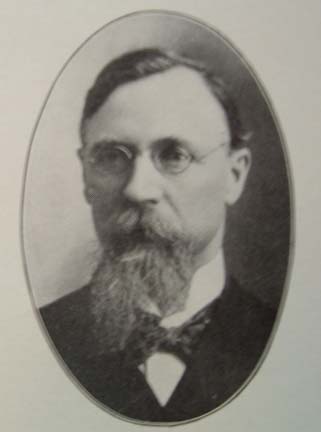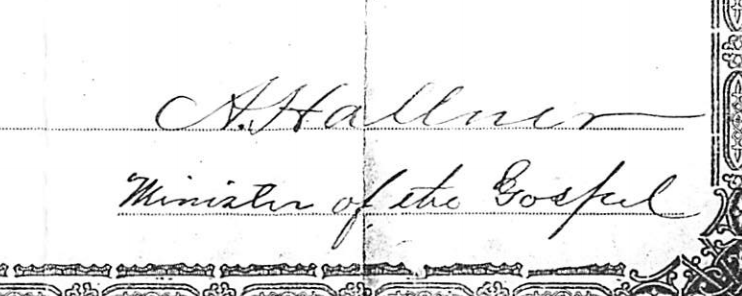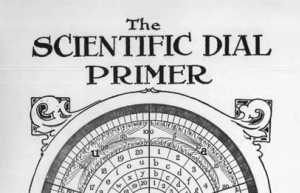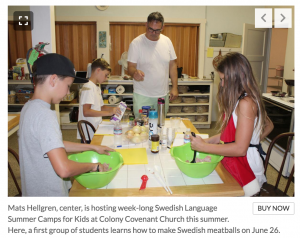Andrew Hallner was a significant person in the lives of my ancestors, in the history of Sunders County and the State of Nebraska, and in the formation of the Evangelical Covenant Church. He has a fascinating life story as well.
 Andrew Hallner was born in 1847 in Remmene parish in Älvsborg County, Sweden. (This is the same general area where my Brodd ancestors came from.) He came to America in 1863 with his parents and five siblings. They first settled in Iowa and later moved to Minnesota. As a young man, Andrew set out on his own to find farmland, looking first in Missouri and then in Saunders County, Nebraska where he found land to his liking in 1870. His parents later joined him there to homestead 160 acres.
Andrew Hallner was born in 1847 in Remmene parish in Älvsborg County, Sweden. (This is the same general area where my Brodd ancestors came from.) He came to America in 1863 with his parents and five siblings. They first settled in Iowa and later moved to Minnesota. As a young man, Andrew set out on his own to find farmland, looking first in Missouri and then in Saunders County, Nebraska where he found land to his liking in 1870. His parents later joined him there to homestead 160 acres.
Andrew was not satisfied to be a farmer. He paid his own way to secure a teaching certificate from the Nebraska State Normal School in Peru, Nebraska. He taught school for a couple of years but still found time to farm with his father.
Andrew came into his own in 1875. A grange movement had started up in Saunders County, and Andrew started making speeches on its behalf. He must have shown himself to be a capable leader; he was selected as a delegate to the State’s constitutional convention1. He became one of the signers of the Nebraska Constitution on June 12, 1875. All of this success led his friends and family to encourage him to study law. He made arrangements to study under Mr. Reese in Wahoo. He was also elected as deacon at the Lutheran Church in nearby Mead and conducted home Bible studies and prayer meetings.
An extraordinary experience during Christmas week in 1875 dramatically changed the course of his life. He was invited to preach and lead services at the Lutheran Church in Swedeburg and made quite an impression.
He took for his text the Forty-Fifth Psalm; the congregation broke down and cried, two infidels were converted, and the meetings were declared a huge success.3
His skills came to the attention of the leaders of the Swedish Mission church movement (the predecessor of the Evangelical Covenant Church). Mission church leaders came to Swedeburg at Hallner’s invitation and preached powerfully to the congregation. Hallner was likewise invited to speak at revival meetings in Iowa while still continuing to preach and teach at Swedeburg. He abandoned his plans to study law.
His involvement at the Lutheran Church in Swedeburg had turned into an unworkable dual arrangement. The Lutheran pastor was leading one part of the congregation, while Hallner and his Mission friends were leading another part. Finally, the pastor and the Lutheran faithful2, who had circulated a petition, asked Hallner to withdraw. According to Hallner,
This decision wounded my spiritual children so deeply and an outstanding brother and older Christian from Sweden, Jöns Mårtenson, sent word to me to come and preach in his house the following Sunday. About sixty members of the Lutheran church came and shortly after that they organized a Mission Church and called me to be their pastor.4

Please note that the “outstanding brother” Jöns Mårtenson was my great-great-grandfather on my dad’s side of the family! Our Jöns (John) went on to become the first chairman of the Swedish Mission Church in Swedeburg.
The founding of the little Fridhem church in Swedeburg marked the beginning of Hallner’s long career in the Swedish Mission church. He went back and forth to Chicago, substituting for Rev. Skogsbergh in Chicago, serving as Secretary of the Swedish Evangelical Mission Synod, and taking charge of the “Mission Vannen” publication. He turned this struggling monthly newspaper to a vibrant weekly publication.
Citing health problems (probably stress!), he returned to Nebraska and continued his efforts in establishing Mission churches. One of these was a few miles south of Swedeburg, the Bethlehem Church at Waverly. A congregation was already informally organized with visiting preachers and a Sunday School hosted at the home of Carl August Rudeen (my 3x-great-uncle).
In 1881, Pastor Hallner began the work of obtaining land and formally organizing a congregation. He included Waverly in a circuit of three different churches in the area. That same year, Pastor Hallner encounters yet another of my ancestors, my great-grandfather Anders Gustaf (Petersson) Rudeen. Hallner’s signature appears on the 1881 marriage certificate for Gust and Augusta.

In 1885, Hallner was once again back in Chicago and was part of a remarkable event on behalf of the Swedish Mission Church; he was one of the original founders of the Evangelical Covenant Church:
At the third session, the question of organizing was put to a formal vote. The question was answered affirmatively with only two or three delegates voting against the motion. Thus, seven men, namely, S. W. Sundberg, Theodore Norlin, Andrew Hallner, A. Larson, C. R. Carlson, J. P. Eagle, and C. J. Nyvall were appointed as a committee to draw up the constitution. The full name of the organization was “The Swedish Evangelical Mission Covenant of America,” known simply as the “Covenant.”5
Clearly, Hallner was a bit of an overachiever and he continued to be plagued by unspecified health troubles. In 1894, he left with his family for California. His strength was sufficient for him to resume his active involvement in founding churches. Churches in California founded by Hallner or led by Hallner in their early years include Kingsburg, Riverside, Riverbend and Turlock. Hallner later credited himself with founding twelve Mission (Covenant) churches in Nebraska and California.
 In his spare time (!), Hallner also became an author. His first book was written before he went to California. It was a pro-prohibition publication called “The Great Campaign”. In 1912, he turned his attention to the completely secular matter of telegraph communications with a book entitled “The Scientific Dial Primer“. A modern-day textbook refers to it as “The World’s Most Bizarre Telegraph Code Book” while another reviewer calls it “a work of imaginative literature.” It is indeed a bizarre book – he basically made up a whole new language based on abbreviated codes.
In his spare time (!), Hallner also became an author. His first book was written before he went to California. It was a pro-prohibition publication called “The Great Campaign”. In 1912, he turned his attention to the completely secular matter of telegraph communications with a book entitled “The Scientific Dial Primer“. A modern-day textbook refers to it as “The World’s Most Bizarre Telegraph Code Book” while another reviewer calls it “a work of imaginative literature.” It is indeed a bizarre book – he basically made up a whole new language based on abbreviated codes.
When war broke out in Europe, Hallner he wrote “Uncle Sam: The Teacher and Administrator of the World“, a patriotic call to action. The man’s energy was apparently boundless, though his publications strike me as almost manic (making me wonder, quite honestly, if his periodic health issues were perhaps part of the sad flip-side of mania).
Also in his spare time (!), he served as organizer and officer of a couple of insurance companies and acted as a land agent for agricultural colonies that recruited Swedes.
Hallner died in 1930 in Turlock, California.
He left a lasting legacy – just last week in fact, the Kingsburg (California) Record newspaper wrote about an upcoming summer program:
KINGSBURG – Swedish language lessons were first taught at Kingsburg’s Colony Covenant Church by Rev. A. Hallner at the turn of the previous century. History is now repeating itself as Swedish native Mats Hellgren has started a series of Swedish Summer Camps. The week-long sessions focus not only on the language, but the culture, foods and games as well.
(I want to go to this camp!!!)
I was surprised to learn that Saunders County had a significant, albeit small, role to play in the formation of the Evangelical Covenant Church. Certainly my great-great-grandfather Jöns Mårtinsson (John Martinson) deserves an “honorable mention” here; would Hallner’s career have taken off had John not opened his home to him?
1Although Nebraska became the 37th State in 1867, their constitution was not adopted until 1875.
2The Lutherans in Swedeberg in 1875 no doubt included the Pearson clan on my mother’s side of the family. Christian Pearson homesteaded near Swedeburg in 1873 and was associated with the Lutheran Church for many years before becoming a Baptist (that’s another story). One might interpret my parents’ marriage in 1958 as the final step in the healing process, reuniting at long last some descendants from both sides of the split – allegorical Montagues and Capulets but this time with a happy ending.
3History of Stanislaus County, California, biographical sketch of Hallner p. 607
4Three Swedish Churchmen from Saunders County, Nebraska, by Robert Greenwall
5D. L. Moody and Swedes: Shaping Evangelical Identity Among Swedish Mission Friends, 1867-1899


I loved this. Now a descendent of Gust and Augusta Rudeen is Pastor of the Covenant Church in Arvada, Co.
Well done Karen!